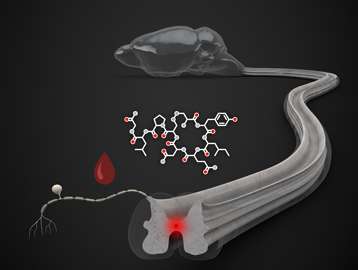30 small neurons join forces against pain

Oxytocin plays a crucial role in modulating the response to pain, but until now the process leading to its release was unknown. An international team, coordinated by Alexandre Charlet, at the CNRS Institut des Neurosciences Cellulaires et Intégratives in Strasbourg (France) and Valery Grinevich from the DKFZ in Germany, has just identified a new pain control center situated in the hypothalamus. It comprises some thirty neurons that are wholly responsible for coordinating the release of oxytocin into the blood and spinal cord, thus reducing painful sensations. These findings, which open new perspectives in the treatment of pathological pain, are detailed in an article published on 3 March 2016 in Neuron.
That hammer blow on the fingers of the weekend DIY enthusiast must have hurt. But it would have been worse if oxytocin, a peptide synthesized by a region in the brain called the hypothalamus, had not intervened very rapidly in the cerebral processes modulating the pain response. From contractions of the uterus during delivery to the release of breast milk after birth, and not forgetting its involvement in regulating social interactions, anxiety or pain, oxytocin is an essential, but currently somewhat mysterious, messenger. Indeed, the mechanisms which lead to its dissemination had never previously been deciphered.
An international team of scientists coordinated by Alexandre Charlet at the CNRS Institut des Neurosciences Cellulaires et Intégratives (France) and Valery Grinevich at DKFZ (Germany) focused on the process underlying oxytocin release when pain is perceived. It discovered that the control center in the brain that coordinates the release of oxytocin only comprises some thirty neurons in the hypothalamus.
During acute pain or inflammatory sensitization (burns, pinching, cuts, etc.), information is transmitted via the peripheral nerves to neurons in the spinal cord. These interpret the intensity of the message and encode it accordingly. The information is then sent to other neurons, which include the small population of 30 small cells in the hypothalamic paraventricular nucleus that has been identified by Alexandre Charlet's team. These in return activate a family of large, magnocellular neurons in another region of the hypothalamus, which release oxytocin into the bloodstream. The target is the peripheral neurons that continue to send the message responsible for pain to the brain. Oxytocin has "anesthetized" them and thus reduced the pain.
However, the thirty controlling neurons do not stop there. In parallel, projections from these cells, or axons, which are up to a meter long in humans, reach the deepest of the ten layers of the spinal cord (where the intensity of the sensory message is encoded) and release oxytocin. Thus via two simultaneous pathways, they diminish retransmission of the pain signal to the brain.
Work by the team has thus explained how different populations of oxytocin neurons are coordinated in order to control interpretation of the "pain" message by the nervous system. Discovery of this analgesic control center is promising in the context of treating pathological pain. Targeting this handful of neurons could indeed diminish the adverse effects of potential therapies. At present, the team is continuing to study them, this time in order to discover their involvement in oxytocin release that enables lactation and certain sexual behaviors.
More information: A new population of parvocellular oxytocin neurons controlling magnocellular neuron activity and inflammatory pain. Neuron, 3 March 2016. DOI: 10.1016/j.neuron.2016.01.041
















